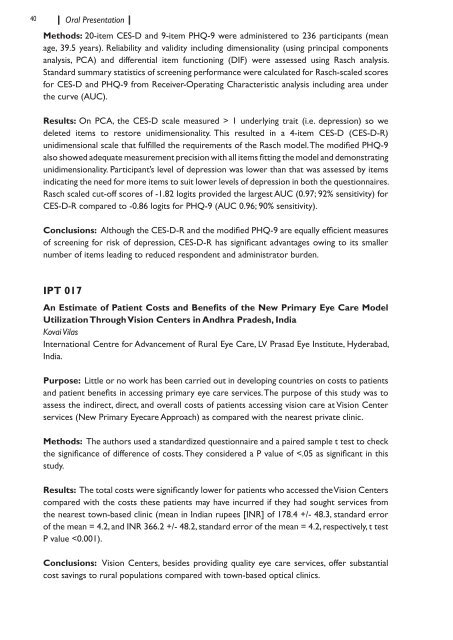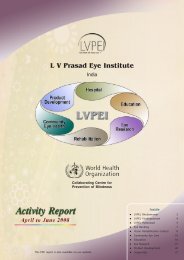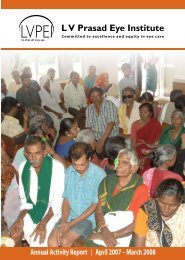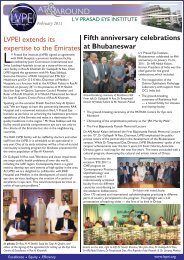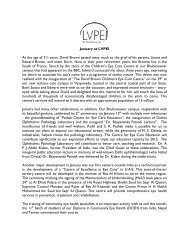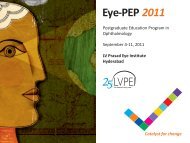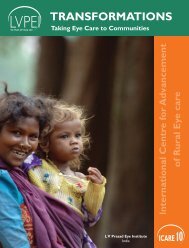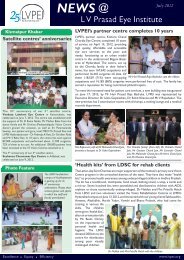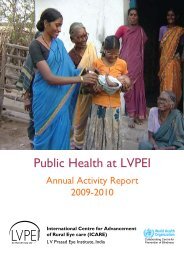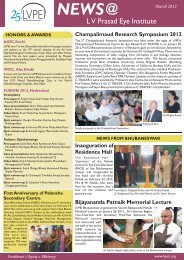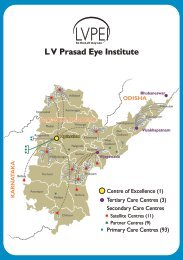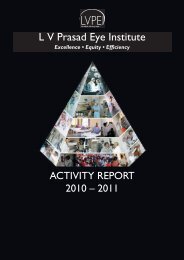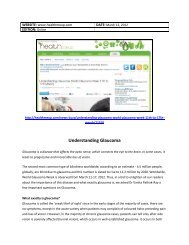IERG Abstracrt Book.indd - LV Prasad Eye Institute
IERG Abstracrt Book.indd - LV Prasad Eye Institute
IERG Abstracrt Book.indd - LV Prasad Eye Institute
Create successful ePaper yourself
Turn your PDF publications into a flip-book with our unique Google optimized e-Paper software.
40 Oral PresentationMethods: 20-item CES-D and 9-item PHQ-9 were administered to 236 participants (meanage, 39.5 years). Reliability and validity including dimensionality (using principal componentsanalysis, PCA) and differential item functioning (DIF) were assessed using Rasch analysis.Standard summary statistics of screening performance were calculated for Rasch-scaled scoresfor CES-D and PHQ-9 from Receiver-Operating Characteristic analysis including area underthe curve (AUC).Results: On PCA, the CES-D scale measured > 1 underlying trait (i.e. depression) so wedeleted items to restore unidimensionality. This resulted in a 4-item CES-D (CES-D-R)unidimensional scale that fulfilled the requirements of the Rasch model. The modified PHQ-9also showed adequate measurement precision with all items fitting the model and demonstratingunidimensionality. Participant’s level of depression was lower than that was assessed by itemsindicating the need for more items to suit lower levels of depression in both the questionnaires.Rasch scaled cut-off scores of -1.82 logits provided the largest AUC (0.97; 92% sensitivity) forCES-D-R compared to -0.86 logits for PHQ-9 (AUC 0.96; 90% sensitivity).Conclusions: Although the CES-D-R and the modified PHQ-9 are equally efficient measuresof screening for risk of depression, CES-D-R has significant advantages owing to its smallernumber of items leading to reduced respondent and administrator burden.IPT 017An Estimate of Patient Costs and Benefits of the New Primary <strong>Eye</strong> Care ModelUtilization Through Vision Centers in Andhra Pradesh, IndiaKovai VilasInternational Centre for Advancement of Rural <strong>Eye</strong> Care, <strong>LV</strong> <strong>Prasad</strong> <strong>Eye</strong> <strong>Institute</strong>, Hyderabad,India.Purpose: Little or no work has been carried out in developing countries on costs to patientsand patient benefits in accessing primary eye care services. The purpose of this study was toassess the indirect, direct, and overall costs of patients accessing vision care at Vision Centerservices (New Primary <strong>Eye</strong>care Approach) as compared with the nearest private clinic.Methods: The authors used a standardized questionnaire and a paired sample t test to checkthe significance of difference of costs. They considered a P value of


